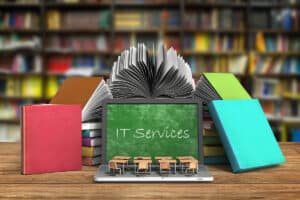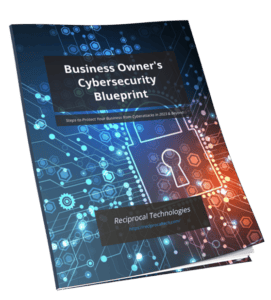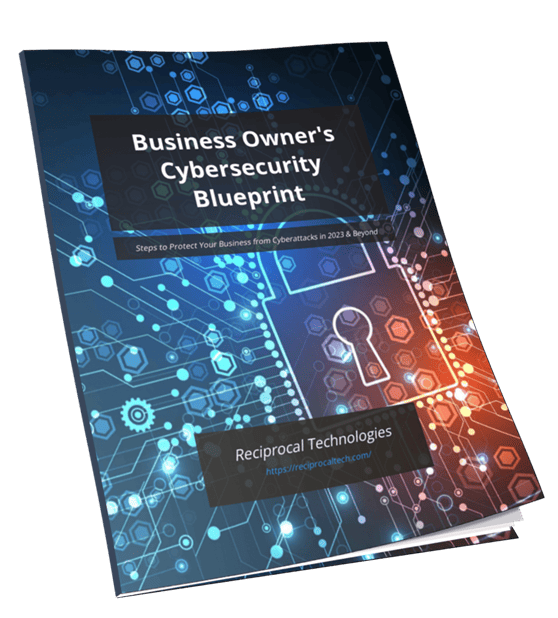IT Management for Schools and Universities: Best Practices and Guide for a Secure Network

A strong IT infrastructure is vital for schools and universities. The importance of having a solid foundation in educational technology cannot be overstated. This infrastructure not only supports teaching and learning but also improves administrative efficiency.
Aspects of strong IT infrastructure include:
- Network reliability: Guarantee seamless connectivity for students and educators.
- Security measures: Protects sensitive data from cyber threats, safeguarding student information and institutional integrity.
- Modern solutions: Incorporates technologies like cloud computing and AI to enhance educational experiences.
As K-12 education and higher education institutions strive to meet the evolving demands of modern learners, the focus on network, security, and innovative solutions becomes vital. Schools face challenges such as outdated systems and tight budgets, while universities seek scalable options to accommodate growth.
We’ll assess critical components of IT infrastructure for schools and universities, providing insights into building secure networks that support both current needs and future advancements.
Evaluating Educational IT Infrastructure Challenges and Needs
K-12 institutions face unique challenges when it comes to their IT infrastructure. Common issues include:
- Limited Budgets: Many schools operate under tight financial constraints, making it difficult to allocate sufficient funds for technology upgrades. This often results in outdated technology that cannot support modern educational demands.
- Outdated Technology: Legacy systems hinder performance, limit remote access, and increase maintenance costs. These systems can also pose security risks. Schools often struggle with aging hardware and software that fails to meet the needs of both educators and students.
- Cybersecurity Threats: As education becomes increasingly digital, the risk of cyberattacks rises. Schools are prime targets for data breaches due to the sensitive nature of student information. A comprehensive approach to cybersecurity helps protects this data.
Addressing these challenges involves several key strategies:
- Conduct Regular Assessments: Continuous evaluation of existing infrastructure allows schools to understand their current capabilities and deficiencies. Regular audits help identify outdated technology that requires immediate attention.
- Prioritize Upgrades: Once assessments are complete, schools can prioritize upgrades based on urgency and available budget. Focusing resources on critical areas first can lead to improved overall performance and security.
- Explore Cost-Effective Solutions: Schools should consider options such as hybrid cloud solutions or virtualization technologies that can maximize existing resources while minimizing costs. By integrating newer technologies with legacy systems, institutions can extend the life of their current infrastructure without complete overhauls.
- Collaborate with Experts: Engaging with IT service providers specializing in educational institutions can yield valuable insights into cost-effective strategies tailored for specific needs.
Upgrading Legacy Systems
Assessing current infrastructure is critical in understanding IT needs for schools. Legacy systems often pose significant risks due to limitations in performance and security.
Risks Associated with Legacy Systems:
- Increased Vulnerability: Outdated technology is more susceptible to cybersecurity threats, exposing sensitive student and institutional data.
- Operational Inefficiency: Performance issues hinder productivity, making it difficult for educators to deliver effective instruction.
- High Maintenance Costs: Older systems require more frequent repairs and support, straining already tight budgets.
Benefits of Modernizing Infrastructure:
- Enhanced Security Measures: Upgrading allows for the implementation of advanced security protocols that protect against cyber threats.
- Improved Performance: Modern systems facilitate faster processing, enabling seamless access to educational resources and applications.
- Scalability and Flexibility: New technology can adapt to growing demands, supporting diverse learning models such as hybrid or remote education.
Steps to Effectively Upgrade Outdated Systems:
- Evaluate Existing Systems: Conduct a thorough assessment to identify gaps and areas needing improvement.
- Prioritize Needs: Tailor solutions based on specific educational requirements and budget constraints in schools.
- Develop a Roadmap: Create a phased approach for infrastructure modernization, considering both immediate needs and long-term goals.
Strategies for Future-Proofing Educational Technology
Investing in a future-proof IT infrastructure is critical for educational institutions aiming to keep pace with rapid technological advancements. To promote long-term viability of IT investments, consider the following strategies:
Incorporate Scalable Technology Solutions
- Assess current and future needs to select technologies that can grow with your institution.
- Look for solutions that allow for easy integration of new features or upgrades without significant overhauls.
- Prioritize vendors offering flexible pricing structures, enabling you to expand services as budgets allow.
Implementing Cloud Solutions in Education
Cloud computing stands out as a key component in modernizing educational infrastructures. By adopting cloud technology, institutions can enjoy several advantages:
Hybrid Solutions
- Balancing on-premises and cloud workloads optimizes resource utilization.
- Hybrid models can leverage existing infrastructure while gradually transitioning to cloud services.
Resource Optimization
- Cloud solutions reduce the burden on local servers and hardware, leading to lower maintenance costs.
- Institutions can scale resources quickly based on demand, particularly during peak usage times like exams or enrollment periods.
Data Transfer Complexities
- Transitioning data to the cloud may present challenges, but implementing robust migration strategies mitigates risks.
- Use data encryption during transfer to safeguard sensitive information and maintaining compliance with regulations.
Enhanced Collaboration
- Cloud platforms facilitate collaboration among students and educators through shared resources and tools.
- Real-time access to materials encourages a more interactive learning environment.
Disaster Recovery and Backup Solutions
- Cloud services often include built-in backup solutions, storing critical data securely off-site.
- This redundancy protects against data loss due to hardware failures or cyber threats.
Investing in scalable technology solutions and embracing cloud computing not only addresses immediate needs but also prepares institutions for future demands. With careful planning and strategic implementation, schools and universities can create an adaptable foundation that nurtures growth while safeguarding student information.
Considerations for Network Security
Network security for universities is a critical aspect of protecting sensitive information. Implementing layered defense strategies enhances the security posture of educational institutions. A proven approach involves adopting zero-trust architectures, which operate on the principle that no one, whether inside or outside the network, should be trusted by default.
Layered Defense Strategies
- Regular Assessments: Conducting periodic assessments of your security measures helps identify vulnerabilities and gaps in your network.
- Multi-Factor Authentication (MFA): Incorporating MFA adds an additional layer of security when accessing sensitive systems, making unauthorized access considerably more challenging.
- Endpoint Protection: Protect all endpoints within your network, including devices used by students and faculty. This prevents malware and other threats from infiltrating your systems.
Utilizing Advanced Security Tools and Strategies
To fortify your network security, consider integrating advanced security tools tailored for educational environments:
- Data Encryption: Encrypt sensitive data both at rest and in transit. This protects against unauthorized access and guarantees that even if data is intercepted, it cannot be easily read.
- Access Controls: Implement strict access controls to regulate who can view or manipulate sensitive information. Role-based access ensures that only authorized personnel have access to critical data.
- Intrusion Detection Systems (IDS): Use IDS to monitor your network for suspicious activities and potential breaches. These systems can alert you in real-time to any unauthorized attempts to access your network.
Compliance with Regulations
Educational institutions must maintain compliance with regulations affecting student data, such as the Family Educational Rights and Privacy Act (FERPA). Non-compliance can lead to severe penalties and compromise student trust.
- Regular Training: Establish training sessions focused on cybersecurity awareness for staff and students. Educate them about best practices for protecting personal information and recognizing phishing attempts.
- Data Governance Policies: Create clear policies outlining how student data is managed, shared, and secured within your institution. This not only helps in compliance but also fosters a culture of responsibility regarding data protection.
By prioritizing these strategies, educational institutions can bolster their defenses against cyber threats while maintaining a secure environment for students and faculty. The integration of advanced tools will further enhance the robustness of your network security framework, allowing for a safer educational experience.
Leveraging Technology to Enhance Learning Experiences
Technology plays can transform educational experiences, enabling personalized learning and fostering collaboration among students. The integration of digital learning tools and interactive learning tools can significantly enhance student outcomes while supporting educators in their teaching methodologies.
Personalized Learning through AI Analytics
- AI analytics offer insights into student performance, allowing for tailored educational experiences.
- These analytics help identify strengths and weaknesses, enabling educators to adjust instruction accordingly.
By leveraging data-driven insights, schools can implement focused interventions that cater to individual learning needs.
The benefits of using AI analytics include:
- Improved engagement through customized content delivery.
- Enhanced tracking of student progress over time.
- Support for diverse learning styles, accommodating both advanced learners and those needing additional assistance.
Collaboration through Digital Tools
Integrating digital tools can foster collaboration, encouraging students to work together effectively. This collaborative approach not only enhances critical thinking but also builds interpersonal skills. Key benefits of using digital tools in the classroom include:
- Real-time communication: Platforms such as Google Classroom or Microsoft Teams facilitate instant interaction between students and teachers.
- Group projects: Collaborative applications enable students to contribute simultaneously on shared documents or presentations, promoting teamwork.
- Access to resources: Cloud-based technologies allow all students to have equitable access to educational materials from anywhere at any time.
Strong IT Infrastructure Through Proactive Management
The importance of IT infrastructure in education cannot be overstated. Continuous assessment and adaptation are integral to meet evolving educational demands. Educational institutions must prioritize proactive management strategies to keep their IT infrastructure effective and secure.
Key actions include:
- Regular Audits: Conduct frequent evaluations of existing systems to identify weaknesses or areas for improvement.
- Feedback Mechanisms: Establish channels for educators and students to report issues or suggest enhancements related to technology use.
- Strategic Roadmap Development: Create a clear plan with milestones for upgrading infrastructure, integrating new technologies, and addressing security concerns.
- Investing in scalable solutions: Plan for infrastructure that can accommodate growth and emerging technologies.
- Adopting hybrid models: Combine on-premises systems with cloud services to enhance flexibility and security.
- Implementing advanced cybersecurity measures: Protect sensitive data through encryption and robust access controls.
By adopting these practices, schools and universities can respond swiftly to technological advancements and changing educational needs. This proactive approach not only enhances operational efficiency but also fosters an environment conducive to learning, ultimately leading to improved student outcomes. The focus on security and modernization is essential for fostering an effective learning environment.
Frequently Asked Questions About IT Management
What is the significance of a robust IT infrastructure in educational settings?
A robust IT infrastructure is vital for schools and universities as it supports educational technology, enhances learning experiences and data security. It enables institutions to implement modern solutions that facilitate personalized learning and improve overall educational outcomes.
What are common challenges faced by K-12 institutions regarding IT infrastructure?
K-12 institutions often face challenges such as outdated technology, limited budgets for upgrades, and increasing cybersecurity threats. These issues can hinder the effective integration of educational technology and compromise the safety of sensitive student data.
How can schools assess their current IT infrastructure needs?
Schools can assess their current IT infrastructure needs by evaluating existing systems, identifying gaps in technology, understanding budget constraints, and considering the specific requirements of their educational environment. This assessment helps tailor solutions that meet their unique demands.
What are the benefits of upgrading legacy systems in educational institutions?
Upgrading legacy systems improves performance, enhances security, and reduces risks associated with outdated technology. Modernizing infrastructure allows schools to implement scalable solutions that support growth and adapt to educational demands.
How can cloud computing benefit educational institutions?
Cloud computing offers several advantages for educational institutions, including flexible storage options, cost savings on hardware, and the ability to balance on-premises and cloud workloads through hybrid solutions. It also simplifies data management while maintaining compliance with regulations affecting student data.
Why is ongoing professional development important for educators in relation to technology?
Ongoing professional development is essential for educators to effectively adopt new technologies and stay informed about cybersecurity practices. Training helps educators utilize digital tools effectively, fostering collaboration among students and enhancing personalized learning experiences.
About the Author
Author’s recent posts
Download the
Business Owner’s Cybersecurity Blueprint


